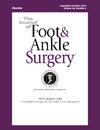Effect of Preoperative Coronal Plane Alignment on Actual Versus Predicted Alignment Using Patient Specific Instrumentation in Total Ankle Replacement
IF 1.3
4区 医学
Q2 Medicine
引用次数: 0
Abstract
Alignment in total ankle replacement is important for success and implant survival. Recently there has been the introduction and adoption of patient specific instrumentation for implantation in total ankle replacement. Current literature does not evaluate the effect of preoperative deformity on accuracy of patient specific instrumentation. A retrospective radiographic analysis was performed on 97 consecutive patients receiving total ankle replacement with patient specific instrumentation to assess the accuracy and reproducibility of the instrumentation. Subgroup analysis evaluated the effect of preoperative deformity. All surgeries were performed by fellowship trained foot and ankle surgeons without industry ties to the implants used. Preoperative and postoperative films were compared to plans based on computerized tomography scans to assess how closely the plan would be implemented in patients. Overall postoperative coronal plane alignment was within 2° of predicted in 87.6% (85 patients). Similarly, overall postoperative sagittal plane alignment was within 2° of predicted in 88.7% (86 patients). Tibial implant size was accurately predicted in 81.4% (79 patients), and talus implant size was correct in 75.3% (73 patients). Patients with preoperative varus deformity had a higher difference between predicted and actual postoperative alignment compared to valgus deformity (1.1° compared to 0.3°, p = .02). A higher average procedure time was found in varus patients, and more adjunctive procedures were needed in patients with varus or valgus deformity, but these were not significant, p > .5. Surgeons can expect a high degree of accuracy when using patient specific instrumentation overall, but less accurate in varus deformity.
在全踝关节置换术中使用患者专用器械,术前冠状面对齐对实际对齐与预测对齐的影响。
全踝关节置换术中的对位对于手术的成功和植入物的存活非常重要。最近,在全踝关节置换术中引入并采用了针对患者的植入器械。目前的文献并未评估术前畸形对患者专用器械准确性的影响。我们对 97 名连续接受全踝关节置换术并使用患者专用器械的患者进行了回顾性影像学分析,以评估器械的准确性和可重复性。分组分析评估了术前畸形的影响。所有手术均由受过专业培训的足踝外科医生完成,所用植入物与行业无关。将术前和术后胶片与基于计算机断层扫描的计划进行比较,以评估计划在患者身上的实施效果。87.6%(85 名患者)的术后冠状面整体对齐度在预测值的 2° 以内。同样,88.7%(86 名患者)的术后矢状面整体对位在预测的 2° 范围内。81.4%(79 名患者)的胫骨植入物尺寸预测准确,75.3%(73 名患者)的距骨植入物尺寸预测正确。与外翻畸形相比,术前有内翻畸形的患者术后预测对位与实际对位的差异更大(1.1°比0.3°,P=0.02)。发现屈曲患者的平均手术时间更长,屈曲或外翻畸形患者需要更多的辅助手术,但这些差异并不显著(P>0.5)。总体而言,外科医生在使用针对特定患者的器械时可望获得较高的准确性,但在曲张畸形患者中准确性较低。
本文章由计算机程序翻译,如有差异,请以英文原文为准。
求助全文
约1分钟内获得全文
求助全文
来源期刊

Journal of Foot & Ankle Surgery
ORTHOPEDICS-SURGERY
CiteScore
2.30
自引率
7.70%
发文量
234
审稿时长
29.8 weeks
期刊介绍:
The Journal of Foot & Ankle Surgery is the leading source for original, clinically-focused articles on the surgical and medical management of the foot and ankle. Each bi-monthly, peer-reviewed issue addresses relevant topics to the profession, such as: adult reconstruction of the forefoot; adult reconstruction of the hindfoot and ankle; diabetes; medicine/rheumatology; pediatrics; research; sports medicine; trauma; and tumors.
 求助内容:
求助内容: 应助结果提醒方式:
应助结果提醒方式:


